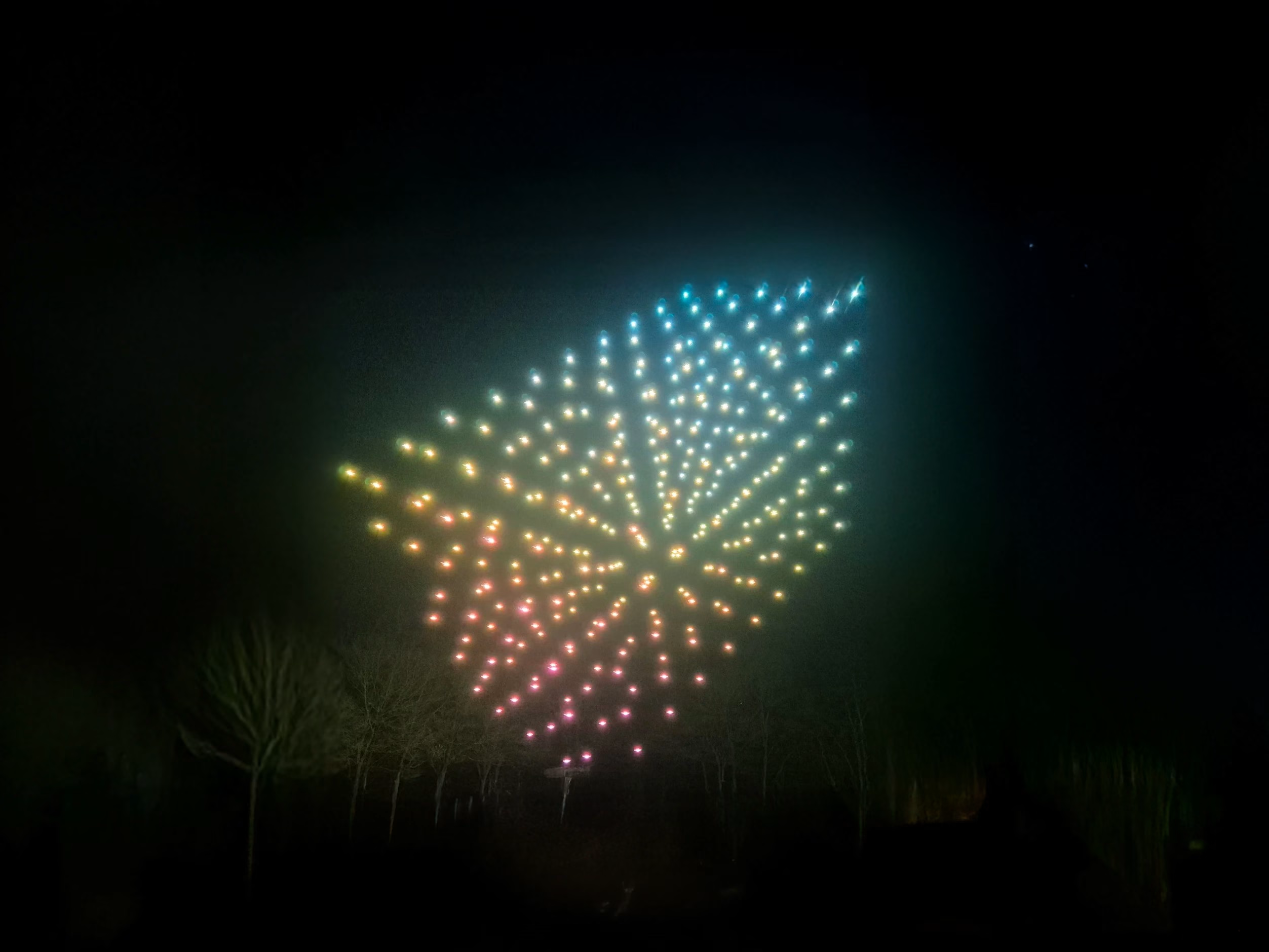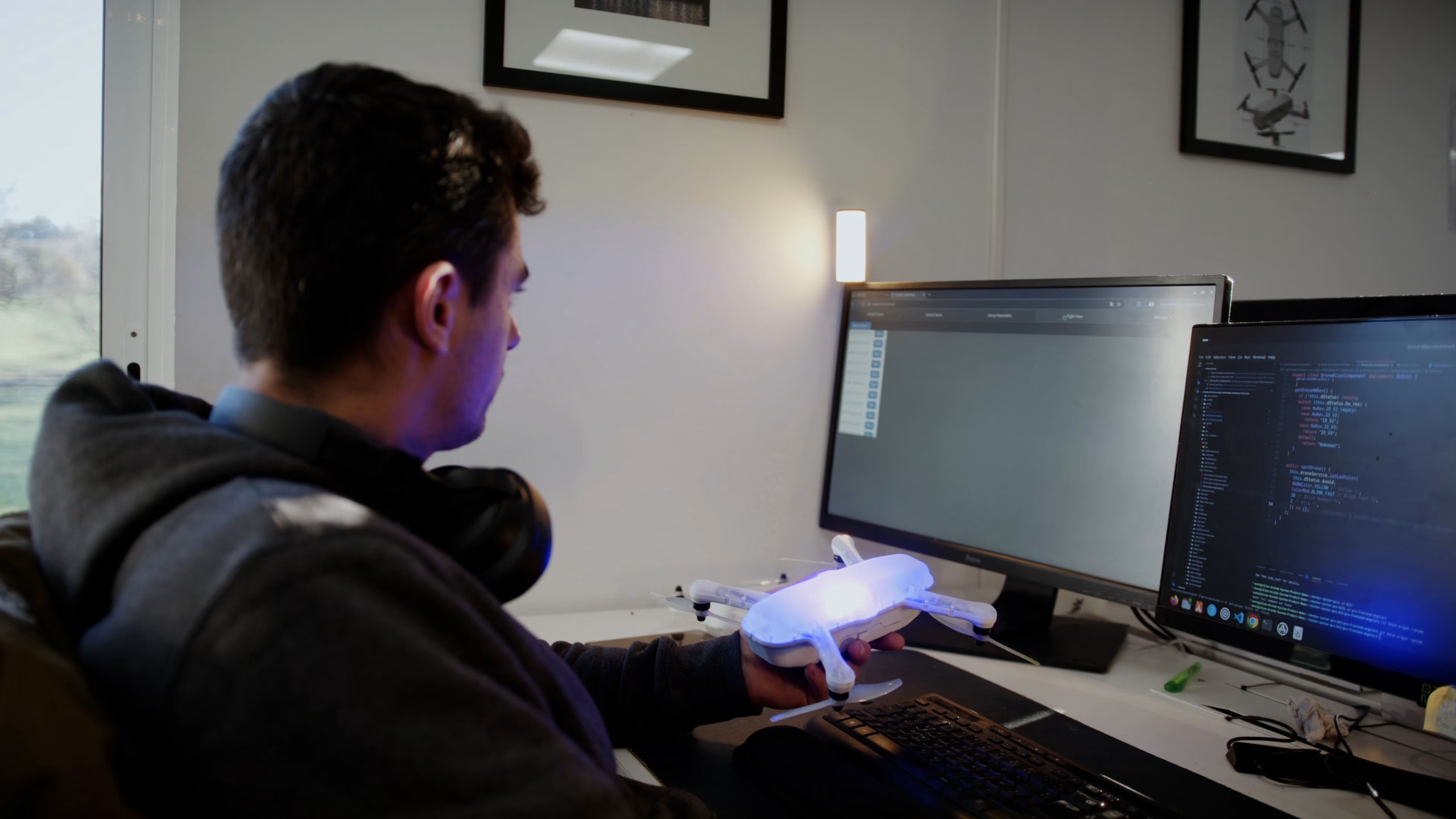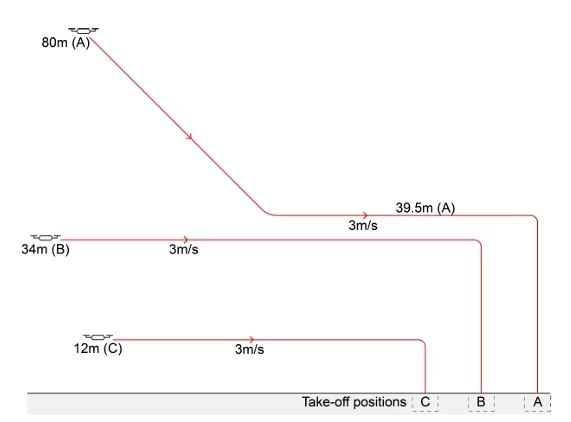Drone light shows are becoming increasingly common these days, giving way to various aerial performances. More and more organizers are turning to this eco-friendly approach as a good alternative to traditional fireworks.
These shows are an effective way of capturing the audience's attention, as the LEDs integrated into the drones create various shapes and animations in the sky. They are synchronized to each other and music for a more immersive experience. A show can contain a fleet of 50, 500, 1.000 drones, or even more if you are ambitious.
If you are unfamiliar with these types of events, you need to know that climate conditions are an essential element of preparation.

Any drone light show aims to impress its audience, and every organizer wants their show to go as smoothly as possible. The weather has a direct impact on the safety and quality of the show.
Adverse conditions will compromise flight stability, disrupt drone operation, or reduce visibility. This will have a major impact not only on performance but also on the audience's point of view.
Drone light shows are often spectacular, but they are also sensitive to a variety of environmental factors. Let's find out what the key elements are that can influence the quality and safety of these events.
Wind is one of the most common natural elements affecting drone shows. Above a certain threshold, which is around 36 km/h, this can affect several elements of your show.
Whether constant or as recurring gusts, it represents a major hazard during flight, for drones and the public alike, because it is difficult to anticipate.
All kinds of precipitation modify atmospheric conditions and air density, directly impacting drones in mid-flight.
Whether it is raindrops, snowflakes, or hail, the ambient lighting will change, and so will the visual quality of the show.
If the temperature is too high or too low, this has a direct impact on the behavior of the equipment deployed in the field and of the drone's electronic components.
Environments that are too hot or too cold will lead to performance differences depending on the drone's thermal tolerance.
Humidity is another factor to consider. If the humidity is too excessive, it can influence the properties of the air and lead to condensation in the drones, directly impacting components.
Finally, fog or low clouds directly affect the visibility of the environment. It is often associated with high humidity and can appear gradually or suddenly.
The level of pollution in the air, dust, and other elements will also affect the visibility of the drone show.
For example, too strong wind can throw drones off balance in the sky, causing them to drift or lose their trajectory, greatly increasing the risk of collisions or crashes.
The drones' sensors can also be damaged, leaving them to behave unpredictably during the show. The slightest deviation due to bad weather can throw the fleet out of sync and cause major damage.
Field operators also need to be able to keep an eye on the drones, which can be compromised in foggy conditions where visibility is severely reduced.
In terms of quality, this affects the legibility of drone figures. Lighting effects won't come out as desired, blurring colors or shapes, ruining the audience's adventure.
In terms of sound ambience, a strong wind can completely cover the show's soundtrack.
Whether the music is synchronized with the drone animation or not, the immersion is broken, preventing the audience from enjoying the experience intended by the organizers.
Constraints may even arise before the drones take off, in the event of weather complications. The installation of ground equipment may be delayed, and consequently, the start of the show.
A powerful wind will also make it difficult to set up the equipment, with the risk of tripods and antennas falling off. Or extreme heat or cold can have a direct impact on drone batteries, affecting charging times and autonomy.
Organizing a drone light show is, above all, a question of preparation and lucidity during the event. Even if the drone show is well managed and perceived as safe, there are still uncontrollable and unpredictable elements that must not be forgotten.
That's why it's essential to check the weather conditions in advance, at least 24 hours before the start of the drone show. You can use our system to benefit from real-time wind information.
With this approach, you can monitor wind strength and direction, and know whether it will have a direct impact on your drone light show.
However, it's a good idea to have a plan B, depending on the situation, and therefore adapt the content of the show, postpone the event to a later date, or even modify some technical aspects recommended by our operators if they are present on site.
In sum, good preparation and rigorous surveillance are the key to ensuring the safety of a drone light show.

Here are the optimal environmental conditions generally recommended by professionals to guarantee a safe, high-quality drone light show.
Wind
• Ideal condition: ≤ 28 km/h
• Admissible limit: > 36 km/h
• Notes: Unpredictable wind gusts can disrupt drone trajectories
Temperature
• Ideal condition: Between 10°C and 25°C
• Admissible limit: < 0°C or > 35°C
• Notes: Below 0°C, we recommend taking the drones outside at the last moment
Relative Humidity
• Ideal condition: 30% to 70%
• Admissible limit: > 85%
• Notes: Risk of condensation in components of the drone
Precipitation
• Ideal condition: 0 mm
• Admissible limit: Any form of rain, snow, or hail
• Notes: Water damages components and impairs visibility
Clouds and Visibility
• Ideal condition: Clear or partly cloudy skies
• Admissible limit: Very low clouds, dense fog
• Notes: We strongly advise against flying in cloudy or foggy conditions
Permitted Altitude
• Ideal condition: ≤ 120 m (FAA/Europe)
• Admissible limit: Depends on the application for the operating permit
• Notes: Authorizations are required if airspaces are controlled
Organizing a drone show in the USA presents unparalleled opportunities, but it also presents many safety challenges due to the diversity of the territory. Conditions vary from one state to another, from areas with strong wind and precipitation to thunderstorms, storms, and tornadoes.
In the West of the USA, we find arid, desert zones subject to intense heat, such as southern Arizona, while the North faces harsh, prolonged winters (Minnesota, Wisconsin, Michigan, Colorado, North Dakota, Alaska).
Depending on the season, the East Coast can be exposed to tropical storms or high humidity. This climatic variety requires rigorous preparation before your drone light show.
Moreover, urban density in certain regions (notably California and New York State) means that we have to deal with strict space, safety, and visibility constraints. Each state has its conditions, and drone light show operators need to adapt accordingly.
Organizing a drone light show in the USA involves studying local regulations and climate conditions in each state. Some cities stand out for their reliable weather and experience of outdoor events.
Las Vegas is undoubtedly one of the safest choices in the USA. Its desert climate, characterized by scarce rain and often clear skies, makes it ideal for drone light shows. The city is also well-versed in large-scale events, which makes logistics and crowd management easier.
Phoenix and Dallas are also well-positioned and enjoy a relatively stable climate for most of the year. However, we still recommend avoiding periods of particularly strong winds or extreme temperatures, especially during the summer months.
Miami, despite its tropical climate, regularly hosts drone shows. However, caution is advised during hurricane season.
Houston has skills in organizing events of all kinds. Outside the hurricane season, its climate is generally conducive to outdoor shows.
Finally, Atlanta offers an interesting alternative with its temperate climate and well-developed infrastructure. Its dense, accessible urban environment makes it easy to accommodate a wide audience. However, you need to stay vigilant during stormy periods, which are more frequent in spring and summer.
In the United States of America, all drone shows must comply with the rules laid down by the Federal Aviation Administration (FAA). The flight operator must hold a commercial drone pilot certificate (Part 107 Remote Pilot Certificate), which governs the professional use of drones.
Light shows generally require authorization to fly at night, and sometimes additional derogations if the flight exceeds standard heights, involves a large number of drones, or takes place in an urban area.
Each application is examined by the FAA, which requires a great deal of upstream preparation and knowledge of the regulatory framework. So it's essential to work with a team accustomed to this type of approach.
In the USA, there are many restricted areas where drone light shows must not be performed: near airports, in military airspace, or around sensitive sites such as prisons, power stations, or national monuments.
In addition to these restrictions, some cities or states apply their own local regulations, which may concern flight times or no-fly zones. It is therefore essential to check all existing local constraints before proceeding with any drone events.
The IO STAR 3 drone ensures a show that keeps its promises - even when the weather throws a wrench in the works.
At Drotek, we have been imagining and designing illuminated drones for several years, enabling our partners to put their wildest ideas into practice. Our years of experience have taught us the importance of having a drone that can withstand any environment.
This is one of the main factors we took into account in the manufacture of our latest model: the IO STAR 3 drone, which has been tested several times in real, sometimes unstable or unpredictable environments.
Designed to face every difficult weather condition, the IO STAR 3 drone is capable of flying in winds of up to 36 km/h while maintaining a stable trajectory and perfect fleet synchronization. This resilience makes all the difference when conditions change rapidly on site.
But that's not all: the IO STAR 3 is also waterproof and splashproof, so it remains operational in light rain or high humidity. Its waterproof structure and protected electronics enable it to perform where other standard drones would disconnect.
Safety features include RTK centimetric GPS, a Geoguard module capable of deactivating a drone that leaves the established zone, and a Flight Termination system that can be activated even in case of a link loss.
Last but not least, its modular design facilitates maintenance, upgrades, and fast technical intervention, even in the field. And for long-term drone shows, its automatic LED cooling system prevents overheating, guaranteeing consistent performance from the first to the last flight.
Whatever the conditions at the event site are, the IO STAR 3 remains the best drone on the market: reliable, easy to maintain, and designed to support you at every show, without compromising on quality.
The IO STAR 3 drone integrates an advanced safety structure, designed to ensure that every flight takes place under the best possible conditions, even in the event of unforeseen circumstances.
These mechanisms, known as failsafes, are at the heart of the drone's reliability and cover several scenarios.
In the event of a lost link or low battery, the IO STAR 3 drone can automatically return to its take-off point. The return is made at a speed of 3 m/s with a dynamic altitude, calculated to avoid obstacles, without interrupting other flight paths.

If the battery falls below a certain level, the drone automatically returns to its starting point.
In the rarest of cases, but for added safety, the IO STAR 3 drone can be used to interrupt flight immediately, via the engine cut-off system. It's triggered remotely via the ground control station, or automatically by the flight controller or Geoguard module.
Three levels are integrated to ensure a response even if a component becomes inoperative:
FMU Kill: software command for shutdown.
ESC Kill: engine controller shutdown via an independent radio module.
Power Kill: complete drone shutdown via the XBee system, even without autopilot feedback.
Our Geoguard is an autonomous system ensuring that each drone remains within its defined flight zone. If it detects excessive speed, exceeded altitude, or loss of GNSS signal, it can neutralize the motors without depending on the main controller.
It complies with European requirements (MOC2511-01) and guarantees full compliance with SORA standards.
With Drotek, you're never alone. From planning to execution, we're here to get your project off the ground with complete confidence.
At Drotek, we don't just supply drones: we support you every step of the way.
Our years of experience give us an edge when it comes to making decisions in the field when the unexpected happens.
From site survey to take-off, our team is there to anticipate unforeseen events, give you advice on the ground, and ensure a smooth and safe operation.
We also take care of all drone regulatory formalities, from authorizations in Europe to FAA approvals in the United States.
On the Big day, our operators are on hand to supervise installation, testing, and the smooth running of the show. All necessary drone show equipment is installed on site: GCS station, calibration systems, and technical support.
And if the weather changes or something unexpected happens, we adjust, postpone, or secure the operation with you, in real time.
At Drotek, we measure our success by our customers' success. Each drone light show is designed with the same objective in mind: to deliver a beautiful, unique, and seamless performance.
Thanks to our technology, our support, and our requirements, we've already set many events apart with a show mastered to perfection.
Our success rate, our responsiveness in the field, and the loyalty of our customers are the best evidence of what we bring to the table: much more than drones, peace of mind.
Drotek is a French company located in South of France. The group has 2 poles of expertise : Electronics – Drone Light Show
Discover our solution: IO Star 3 Drone - Ground Control Station - Software - Drone Charging Station - All-in-one platform